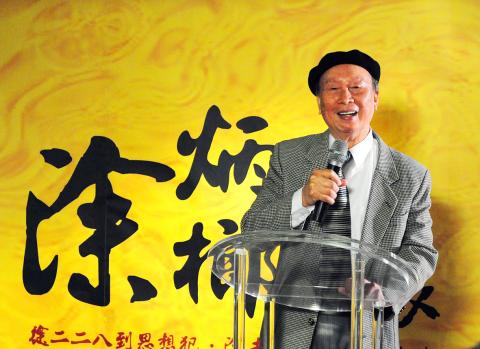|
228 ANNIVERSARY:
Painter remembers dark days of Martial Law period
COPING MECHANISM: After his release from jail,
Tu Ping-lang turned to Buddhist art, choosing forgiveness to come to terms with
the suffering he had experienced
By Chiu Shao-wen and Jason Pan / Staff reporter, with staff
writer

Tu Ping-lang, an 84-year-old
painter, speaks on Tuesday at the opening of his exhibition at the Taipei 228
Memorial Museum. The exhibition, which marks the 66th anniversary of the 228
Massacre, is open through May 26.
Photo: Chiu Shao-wen, Taipei Times
Artist Tu Ping-lang (Ò\¬±·}) lived through
one of the darkest chapters of Taiwan¡¦s history, his story a testimony to the
atrocities and brutal human rights violations perpetrated by the Chinese
Nationalist Party (KMT) regime following its takeover of Taiwan in 1947.
Known as ¡§the painter who has seen the face of hell,¡¨ Tu was jailed for 10 years
for attending a student study group during the White Terror era, when the KMT,
led by Chiang Kai-shek (½±¤¶¥Û), imposed martial law.
Now 84, he is the featured artist in this year¡¦s 228 program, ¡§Special
Exhibition of Tu Ping-lang,¡¨ organized by the Taipei City Department of Cultural
Affairs.
Narrating Tu¡¦s life story, the exhibition displays a series of photographs,
historical documents, police files and portraits of Buddha he painted after his
release from prison.
Born in Pozih City (¦µ¤l), Chiayi County, his father was Tu Lu (Ò\Äl), the respected
director of the city¡¦s Rihsin Hospital and uncle of Tu Hsing-che (Ò\¿ôõ), a former
department of health minister.
Following clashes between the authorities and civilians on Feb. 27 and Feb. 28,
1947, Tu Ping-lang, at the time a 16-year-old student at Chiayi Senior High
School, skipped class and returned to Pozih to help organize a volunteer student
corps to preserve law and order in the city.
When the incidents came to a head in the following month in the ¡§228 Massacre,¡¨
Tu hid at home when KMT soldiers came to town. Afterward, he turned himself in
at the local police station, and was lucky to only receive a one-year suspension
from school.
After the events of 1947, Tu transferred to Chienkuo Senior High School in
Taipei, but he did not graduate. He studied at home and was admitted to the
Faculty of Arts at the Taiwan Provincial Teachers College (TPTC) in Taipei,
which is now National Taiwan Normal University.
Tu was a classmate of the renowned Taiwanese sculptor Yang Ying-feng (·¨^·) in
the college¡¦s inaugural year.
In 1949, two students were involved in a dispute with police in Taipei¡¦s Fourth
Precinct. The students, one from TPTC and the other from National Taiwan
University (NTU) were beaten up and detained by the police.
Subsequently, hundreds of NTU and TPTC students organized a march to denounce
police brutality, then surrounded the police precinct demanding the pair¡¦s
release.
The KMT government used force to suppress the students, sending troops to
surround dormitories at NTU and TPTC on April 6. They stormed the dormitory
rooms and dragged about 100 students outside before arresting them. Seven
students were summarily executed, while others were thrown in jail.
Tu participated in the initial protest against the police, but once again, luck
was on his side. On the night of the dormitories raid, he was playing mahjong at
a fellow student¡¦s house and escaped once again.
However, it was not long before his luck ran out.
In 1951, NTU student Chen Yuan-chih (³¯¤¸´¼) turned himself in to the authorities.
Seeking leniency, Chen betrayed his friends by admitting he had attended a
student study group two years earlier. According to his confession, the student
group was reading about ¡§Dialectical Materialism,¡¨ which was associated with the
thoughts and discourse of Karl Marx. The KMT considered anyone reading such
material as leftists and communist-sympathizers.
Chen named seven other students at the reading session, six NTU students and one
from TPTC, who were subsequently arrested. Tu was the TPTC student.
The seven were tried by a military court and Tu was sentenced to 10 years in
prison, after which he was incarcerated at the military jail in Ankeng (¦w§|),
Sindian (·s©±), in what was then Taipei County.
Looking back on the twists of fate in his life, Tu said his father was a
well-known medical doctor who studied in Japan and was respected by local
people, but ¡§in those days with the KMT regime, no one could help me.¡¨
¡§At that time, the KMT encouraged informers. If you confessed and they caught
someone else as a result, you received a financial reward and a job promotion.
It was more profitable than working at a regular job,¡¨ he said.
Tu looks back with sadness.
¡§It was a tragedy of history,¡¨ that he was caught up in three important episodes
of KMT suppression.
¡§The painter who has seen the face of hell¡¨ said that initially, being locked up
was agonizing, but later he became totally desensitized.
Tu Lu waited for his son to return and left an empty chair at the family meal
table in the hope that his son would come back home safely.
During the first few years of his jail term, Tu Ping-lang said he never dared to
think that one day he would walk out a free man again. Only later, when he saw a
fellow prisoner released after serving a five-year term, did he think he had a
chance of regaining his freedom.
Thanks to his painting skills, some military officials at the jail asked him to
paint pictures to cheer everyone up. In return, he received better treatment
than most.
After his release, Tu Ping-lang turned to Buddhist art, choosing mercy and
forgiveness to deal with the suffering he had experienced.
|
![]()
![]()
![]()